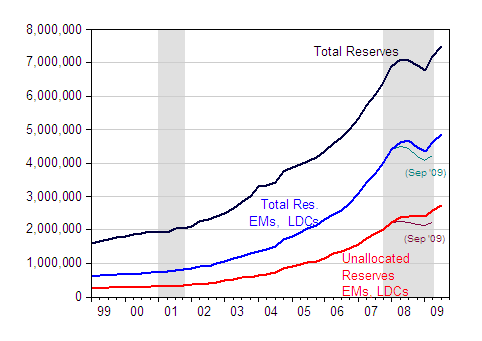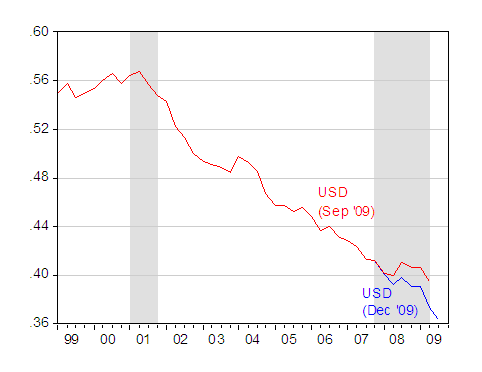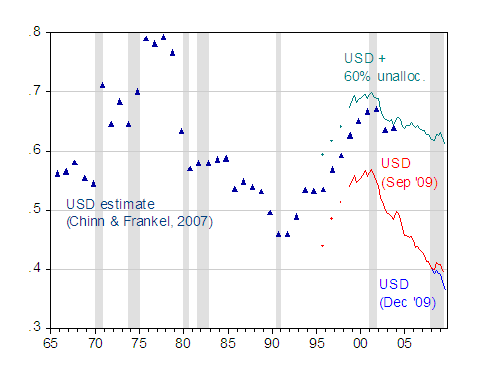Perhaps the most startling thing about the new COFER data on reserves released by the IMF is not the declining dollar share in total reserves, but rather the fact that reserves have risen relative to where we thought they were [0]. The change is entirely due to the upward revision in unallocated reserves by emerging market and LDC central banks. This point is shown in Figure 1.

Figure 1: Total reserves, in millions of US dollars (black), emerging market central banks from December 30 (bold blue), from September 30 (teal); emerging market unallocated reserves from December 30 (bold red), from September 30 (purple). NBER defined recession dates shaded gray, assumes recession ends 09Q2. Source: COFER, September 30 and December 30, 2009, and NBER.
Total reserves were revised up $381 billion in 2009Q2, as were total emerging market/LDC reserves, and unallocated emerging market/LDC reserves. The revision in total reserves constituted a 5.5% change – quite substantial.
A straightforward interpretation of the data also reveals a continued — and exacerbated — decline in the identified US dollar share of total reserves.

Figure 2: US dollar share out of total reserves from September 30 (red), and from December 30 (blue). Source: COFER, September 30, and December 30, 2009, and NBER.
Of course, as I and many others have observed before, a large portion of the unallocated share is in dollars. I update my figure incorporating a longer span of IMF estimates (from Chinn and Frankel (2007)).

Figure 3: US dollar share of total reserves from September 30 (red), from December 30 (blue), US dollar plus 60% of unallocated reserves from December (teal triangles), and Chinn-Frankel (2007) US dollar share series based on IMF data (dark blue). NBER defined recession dates shaded gray, assumes last recession ends 09Q2. Source: IMF, COFER, September 30 and December 30, 2009, Chinn and Frankel (2007) NBER and author’s calculations.
In this case, I’ve once again used a 60% estimate for the dollar share of unallocated. China accounts for the largest share of these unallocated reserves, and in posts from last March, Brad Setser estimates the Chinese hold 65% of their reserves in dollars — so 60% seems reasonable to me.
Taking this adjustment into account, the dollar share’s drop seems a bit less precipitous, and certainly less marked than some other movements in the past 30 years.
Some research on total reserve accumulation in the context of the Trilemma here and here.
Update: 1/11/10, 1:40pm Pacific:
Regarding the “revisions”, Matt Higgins at NY Fed observes:
The figures in the COFER database, whether EM or globally, exactly match item 1d.d, Foreign Exchange, in International Financial Statistics. One can confirm that directly by translating the relevant line item in the IFS global table (hard copy or diskette) from SDRs to U.S. dollars. For some reason, beginning in the spring of 2008, IFS began showing the Foreign Exchange line item for Developing Asia and for China as n/a; this continued up through the diskette we received for November 2009. Despite this fact, IFS continued to report a total for Emerging and Developing Economies overall; and COFER continued to faithfully replicate that total.
As of the December 2009 IFS release, however, reserve figures are reported for Developing Asia and for China–and the EM total has been revised upward exactly by the reserve increase in China. In the IFS diskette, this applies to each month after April 2008: May 2008 has been revised upward by the change in Chinese reserves for May; June 2008 has been revised upward by the change in Chinese reserves for May and June; and etc. all the way up to September 2009. The upward “revision” in the COFER EM total between Q2 and Q3 reflects only the fact that Chinese reserves had been frozen at their April 2008 value for the preceding year and a half.
This reporting gap is odd because China had been continuing to release reserve data all along, even if monthly figures came out only after the end of the quarter.
If I understand correctly what the term “reserves” means when applied to foreign central banks, they come from either trade surpluses or financial inflows. They can of course be adjusted by FX actions.
With the US trade deficit falling nearly in half, it’s not too surprising the dollar share might go down. But an increase in total reserves would be hard to explain with the backdrop of a decline in global trade. So that would leave financial inflows. Looking at EM stock prices, bond prices, and currency exchange rates vs. the buck in 2Q, it seems to me financial flows is what is doing it. Some EMs started FX intervention and exchange/capital controls, but that wasn’t until 3Q.
Is my understanding of this correct? Roubini has been talking a lot lately about the dollar carry trade, so we may have identified something that Fed ZIRP rates are successful at accomplishing. The world used to have to rely on Japan for this service.(and the Swiss, to a lesser extent.)
Also I was wondering what is the difference between unallocated dollar reserves and the allocated kind? Meaning what makes them classified either way?
M. Pettis just posted a very long blog on the state of the Chinese economy. With all the popular press about the wonderful success of China’s stim program and it’s world beating post Great Recession growth, things don’t look that great when you pop the hood and take a closer look at how the engine is running.
He also predicts 2010 is the year when the trade wars begin in earnest.
“China new year, and one more vote for GDP-adjusted bonds”
http://mpettis.com/
Menzie,
From today’s NFP, further evidence that job losses are structural. I suppose my question to you would be, given any regression on historical data, where would you expect duration of unemployment (%>26wks)to peak? And if the regression models “aren’t working”, why aren’t they?
http://1.bp.blogspot.com/_pMscxxELHEg/S0dSamkpncI/AAAAAAAAHNU/8xA6hqTts6c/s1600-h/UnemployedOver26Weeks.jpg
The reserve growth tells me a competitive-devaluation-type war trade war is already underway. So far, however, it is being waged by just one side.